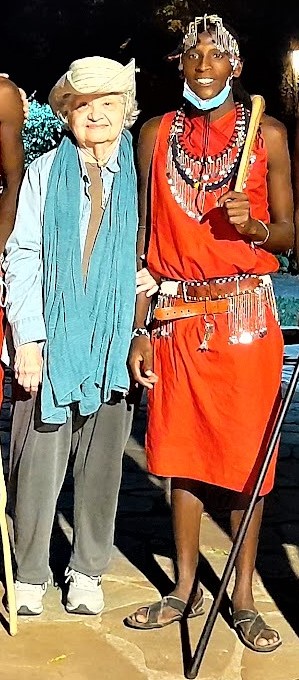» posted on Thursday, September 15th, 2022 by Linda Lou Burton
They Came To Dance
Linda Lou Burton posting from Sarova Mara Game Camp, Maasai Mara National Reserve, Kenya–I said I wouldn’t miss it. They came to dance, and I was there to watch. It wasn’t  authentic, as far as the setting, and the glittery stuff that sparkled in the artificial light. A stone and concrete patio around a pool of aquamarine water doesn’t speak of tradition. But we got the SOUND of it, the idea of what it was meant to tell us. Our gang was there, part of the tourist crowd. The show was staged for tourists, a group hired by Sarova, or maybe the park itself, to make the rounds of the fancy-schmancy lodges and camps that pepper the Maasai Mara Reserve. That’s a good thing – tourist dollars helping the locals. As for the tourists, it opened the door for us to learn some Maasai history; appreciate their heritage. And that’s a good thing too.
authentic, as far as the setting, and the glittery stuff that sparkled in the artificial light. A stone and concrete patio around a pool of aquamarine water doesn’t speak of tradition. But we got the SOUND of it, the idea of what it was meant to tell us. Our gang was there, part of the tourist crowd. The show was staged for tourists, a group hired by Sarova, or maybe the park itself, to make the rounds of the fancy-schmancy lodges and camps that pepper the Maasai Mara Reserve. That’s a good thing – tourist dollars helping the locals. As for the tourists, it opened the door for us to learn some Maasai history; appreciate their heritage. And that’s a good thing too.
Did you know there are more than a million Maasai? Most live in Kenya, some in Tanzania. Their spoken language is MAA; the name “Maasai” means “people who speak MAA.” Their cows are their most prized possessions – their security, and wealth. Semi-nomadic, they move their homes and herd their cattle in a seasonal rotation. And they hunt lions – never for fun, only if needed to protect their homes and cattle. The Maasai are known for their physical beauty – both their strong, slender, graceful physiques and their unique clothing and body ornamentation. Maasai dress is distinctive, and often copied by fashion designers.
 The SHUKA. Made of animal skins in the beginning; today these wrap-around blankets are woven cotton, purchased, not handmade. The distinctive coloring and fabric design tells of family connection – like the Scottish plaids of the clans. Red is the most-used color; brilliant blues and yellows are used too, in various designs of plaids and stripes and checks. (Online Photo)
The SHUKA. Made of animal skins in the beginning; today these wrap-around blankets are woven cotton, purchased, not handmade. The distinctive coloring and fabric design tells of family connection – like the Scottish plaids of the clans. Red is the most-used color; brilliant blues and yellows are used too, in various designs of plaids and stripes and checks. (Online Photo)
The DANCES. Imagine the dances in the wide open spaces, circled round a fire. Start with the ADAMU, known as the jumping dance. It is joyful, and cocky, a show-off dance. Who can jump the highest? Who is strongest, bravest? Who will attract the best wife? Lots of shouting and whoops, laughter or praise, as each takes a turn stepping in front of the group and jumping as high as he can. The music is created on the spot: voices chanting, modulated, call and response; the perfect soundtrack for what they do; it changes, underscores, leads. The hunting dance; encouragement and morale building as they ready to kill a lion. Friendship and family, celebrating a birth, or a wedding. Grief, and mourning a terrible loss.
We couldn’t follow the words, but the tone and movement told each story well. We asked questions at the end; posed for photos too. I bought a shuka from their table by the pool; the red and black checks my choice. So much to learn about the Maasai, in the days ahead.
Sarova Mara Game Camp https://www.sarovahotels.com/maracamp-masai-mara/
